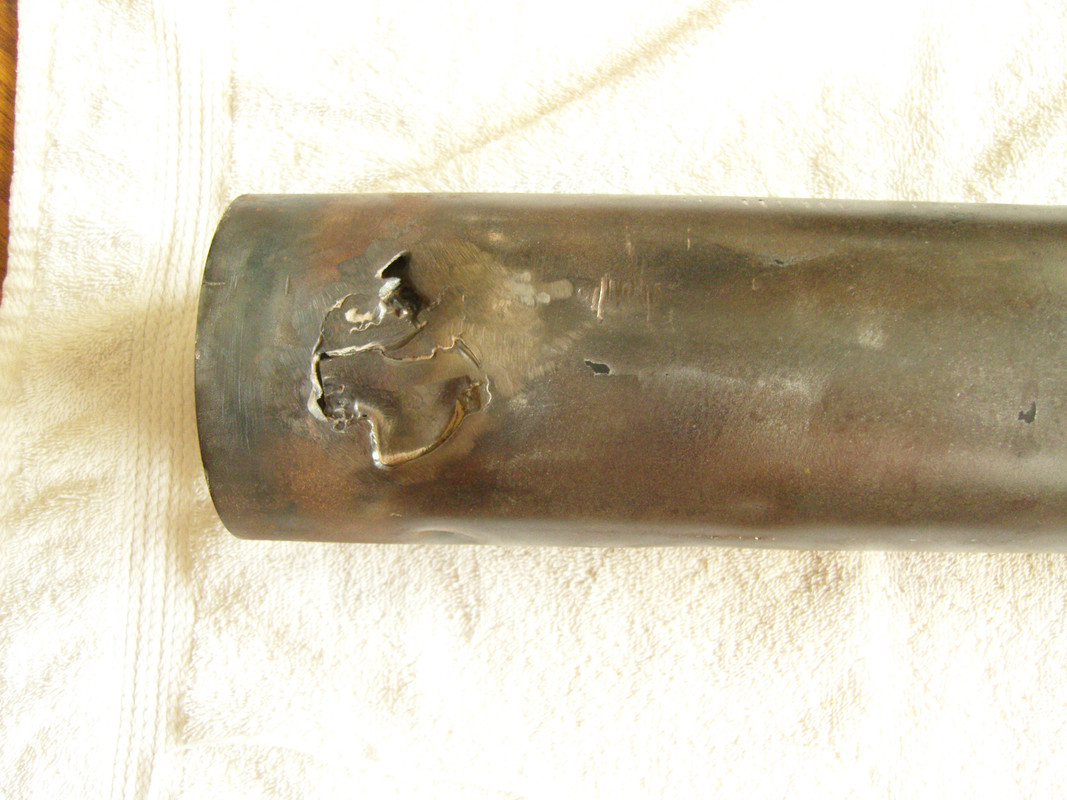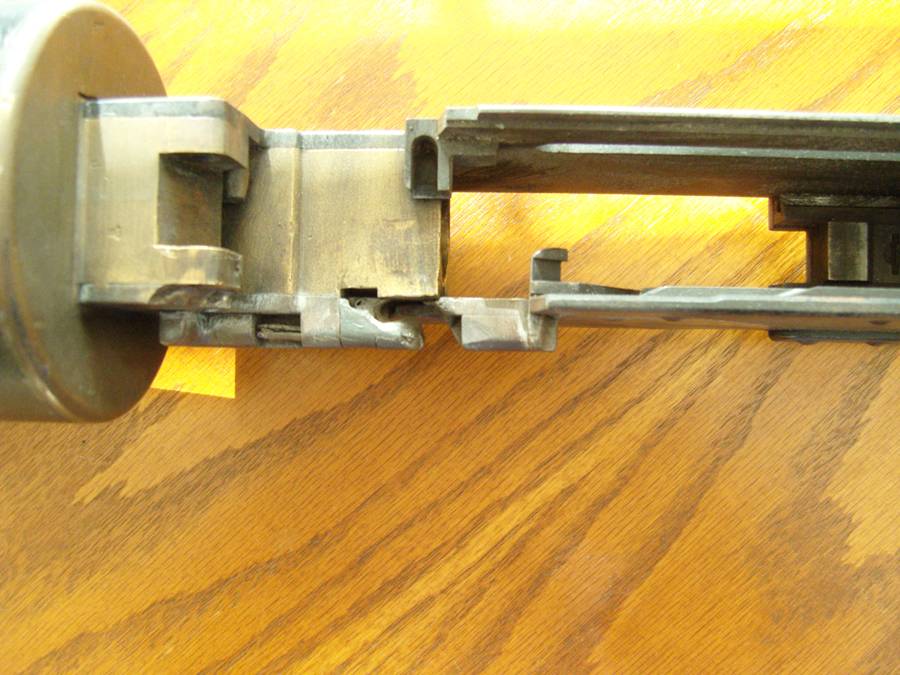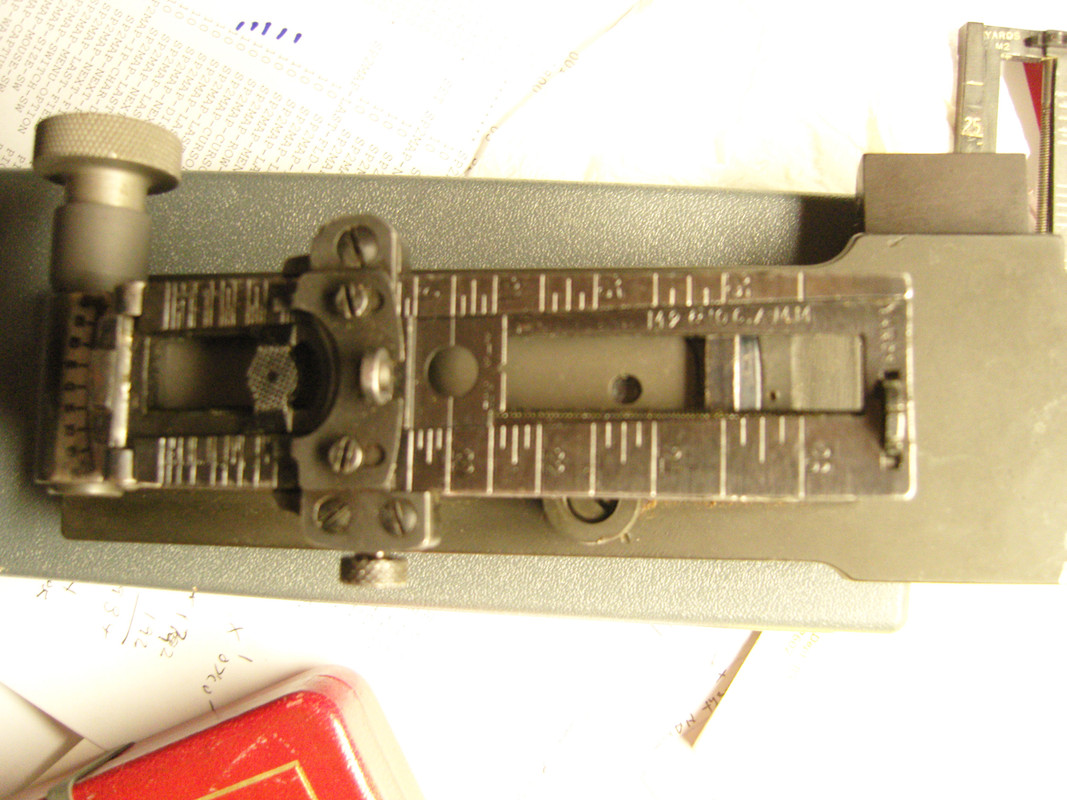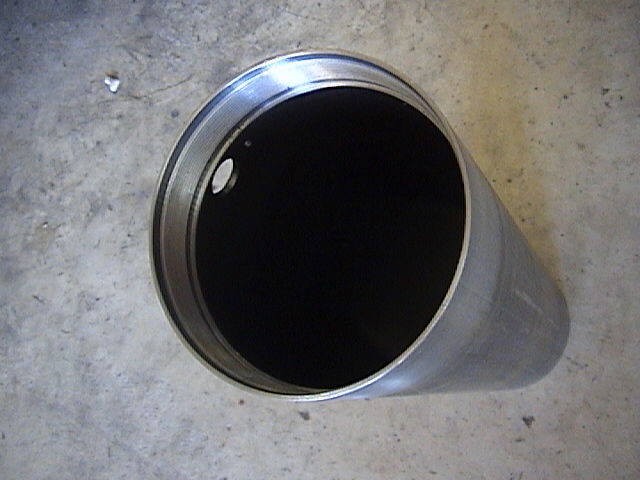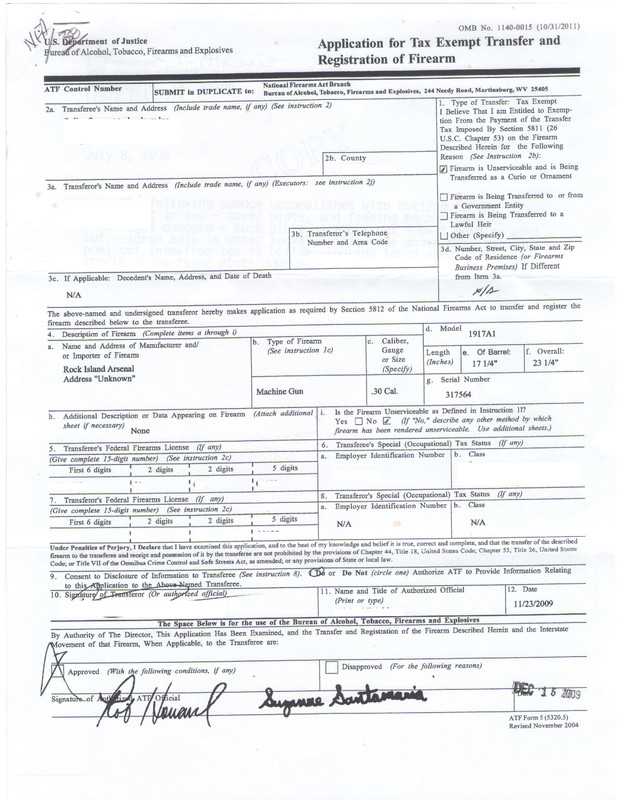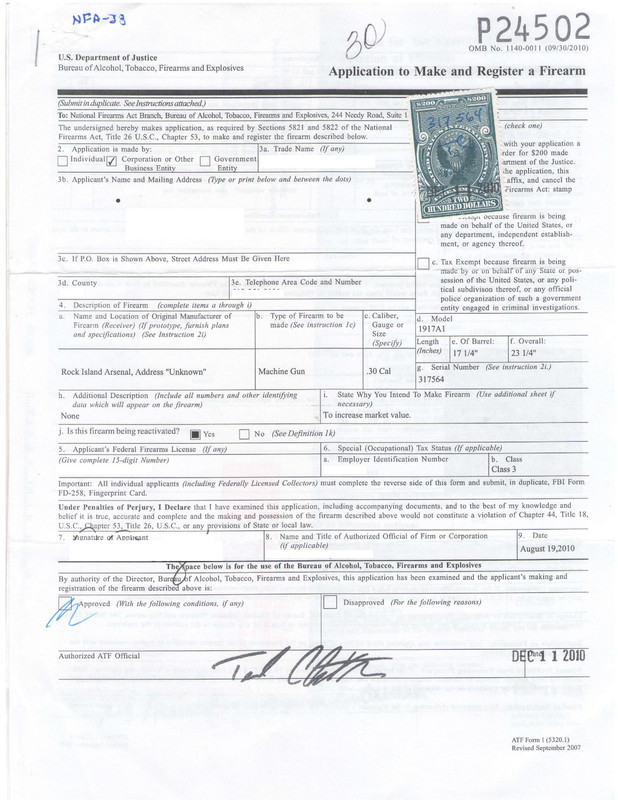In 2009 while I was perusing Gun Broker, I spotted a DEWATed 1917A1 Browning water cooled machine gun just sitting there. It had no bids on it whatsoever after being listed for two weeks. Being curious, I contacted the seller and discovered this Browning was coming out of a museum in Portsmouth, VA that was closing its doors. After a great deal of consternation and consultations with knowledgeable people, I decided to bid on it. I estimated that an after-market Browning registered right hand side plate was worth $10K all by itself, the RIA marked 1917A1 tripod was worth $1500, and the un-demilled components were worth $2000. I placed a bid of $10K on it. If worse turned to worse I could disassemble everything as sell the pieces and parts separately and make $3500.
To make a long story short, the 1917A1 turned out to be a real, honest to goodness, WWII Marine Corps veteran of the South Pacific War. It was declared surplus by the US Navy in 1948 and sent to the scrap yard in Norfolk. There it was de-milled and registered as a DEWAT. It was then sold to an 18 year old kid who patched the DEWAT damage with auto body putty and painted it black. He kept it in his basement for 50 years. The museum acquired it in 1998 where it was kept on display for over ten years.
Doing my research I discovered it was part of the original September 1941 US government order to Rock Island Arsenal for some 78,000 1917A1 water cooled Brownings. Based on the weapon's serial number, it was manufactured in November 1942. It was sent to the US Navy where it was issued to the US Marine Corps. In 2009 there are only 36 known RIA 1917A1 Browning water cooled machine guns from the original 1941 order left in existence. That's it. The rest were all used up, scrapped, and destroyed. Unlike civilian contracted arms makers (High Standard, Westinghouse, Colt, Browning, Winchester, Remington, IBM, etc.), the US government never released weapons manufactured at government owned facilities for civilian sales. Rock Island Arsenal was US government owned, hence weapons made by them were never released.
It took over two years to find the correct RIA components to replace those damaged during the de-milling process. After completing the required BATFE paperwork, my 1917A1 was re-classified as a live machine gun. I then had it, plus the 1940 RIA 1917A1 tripod, rebuilt and refinished to "as issued" condition. It performs perfectly.
Since the now fully functional machine gun was manufactured over 50 years ago in 1942 it is also classified as a C&R weapon. Ain't government rules and regulations wonderful?
This is a completely restored, fully functional, full auto weapon. It is 100% correct and is as close to "as issued" as one can get. I paid my $200 and waited for BATFE's permission to re-activate it. I also wanted a "Tax Stamp" to keep with the weapon. I could have had a friend, a Class 2 manufacturer, do the reactivation for no cost. But in that case I would have needed to transfer the weapon to him (Form 3 with six week wait), he re-activates weapon (Form 2 with six week wait), and transfer back to me (Form 3 with six week wait). No tax stamp would be forthcoming using this scenario.
A Little History: At the end of WWI, the US had 68,000 Browning 1917 belt bed machine guns in inventory. By the end of 1940 there were less that 20,000 in inventory. The remainder of the 68,000 were worn out and scrapped, left on site at the end of various military actions, sent to allies, or sent to the UK on Lend Lease during the dark days of early WWII. In September of 1941 it was decided to order some 47,000 1917A1 Browning belt fed machine guns from the US Government arsenal at Rock Island Illinois. All of the WWI issued Browning belt fed guns were manufactured by the commercial firms of Remington, Colt, and New England Westinghouse. None were US Government made. RIA began building the weapons in January of 1942. As they came off the assembly line they were immediately placed into service. Most were used up or destroyed by the end of WWII. Of the 47,000 produced from this September 1941 order, today less than 40 are known to survive today. Most of these reside in museums.
It took me over two years to rebuild this weapon. Period correct RIA pieces and parts are few and far between. There are also very few talented gunsmiths with the tools, experience, and knowledge capable to do a correct rebuild.
The right side plate, the part BATFE considers to be the weapon, was undamaged and needed nothing. Other parts were not so lucky.
The water jacket was battle damaged and had to be replaced.
The complete top cover and sight assembly were torch cut and not fixable.
The left side plate was torch cut and also not repairable.
Of course the barrel needed replacement too, but they are readily available as were the other minor missing components. The 1940 RIA 1917A1 tripod also needed the replacement of the torch cut parts, missing pins, nuts, bolts, washers, and screws. Luckily these are all readily available.
The hardest and most expensive part to locate was the original RIA WWII manufacture 1917A1 left side plate.
The top cover assembly was also quite scarce as it contained all the period correct inter-war components.
A new water jacket was manufactured using original Colt specifications and blueprints.
I corresponded with weapons experts and collectors in France, UK, Luxembourg, New Zealand, South Africa, and here in the US. I needed to get pictures of all the markings and inspector stamps so I could verify the correctness of my restoration. The UK and French collectors were especially helpful.
Gunsmiths of note who I relied on were Jeff Prater of Iron Creations in Morrow, OH, Karl Kurkey of K3 Machine Tools in Houston, and John B. McGuire in McMinnville, TN. Jeff Prater supplied the newly machined water jacket. The old damaged water jacket was removed and the new water jacket was re-soldered in place by Karl Kurkey. At that point everything was delivered to John McGuire who completely disassembled the weapon from the trunnion rearward. He then re-riveted, refinished, and tested the weapon. Damaged and missing tripod components were acquired from Numrich in Kingston, NY. Alex Krueger, formerly of the Nimitz Museum in Fredericksburg, TX, rebuilt and correctly refinished the tripod. Now you can see why it took my two years to get her up and running.
The '17A1 was legally de-milled by the then, 1948, standards. Prior to the '86 ban, there was little if any interest in full auto weapons and they had little value.
The transfer of possession of a DEWAT has the same federal paperwork and background check requirements as a live weapon. You must have BATFE's blessings. Sorry, but there is no loophole. The only difference is that this transfer is tax free on a Form 5. Other than that, everything is identical to a $200 taxable transfer via a Form 4.
I did not register, or re-register, that weapon. That was done in 1948 when it was DEWATed. All I did was "re-activate" a currently registered inactive weapon via a $200 tax Form 1.
Finally here she is today:
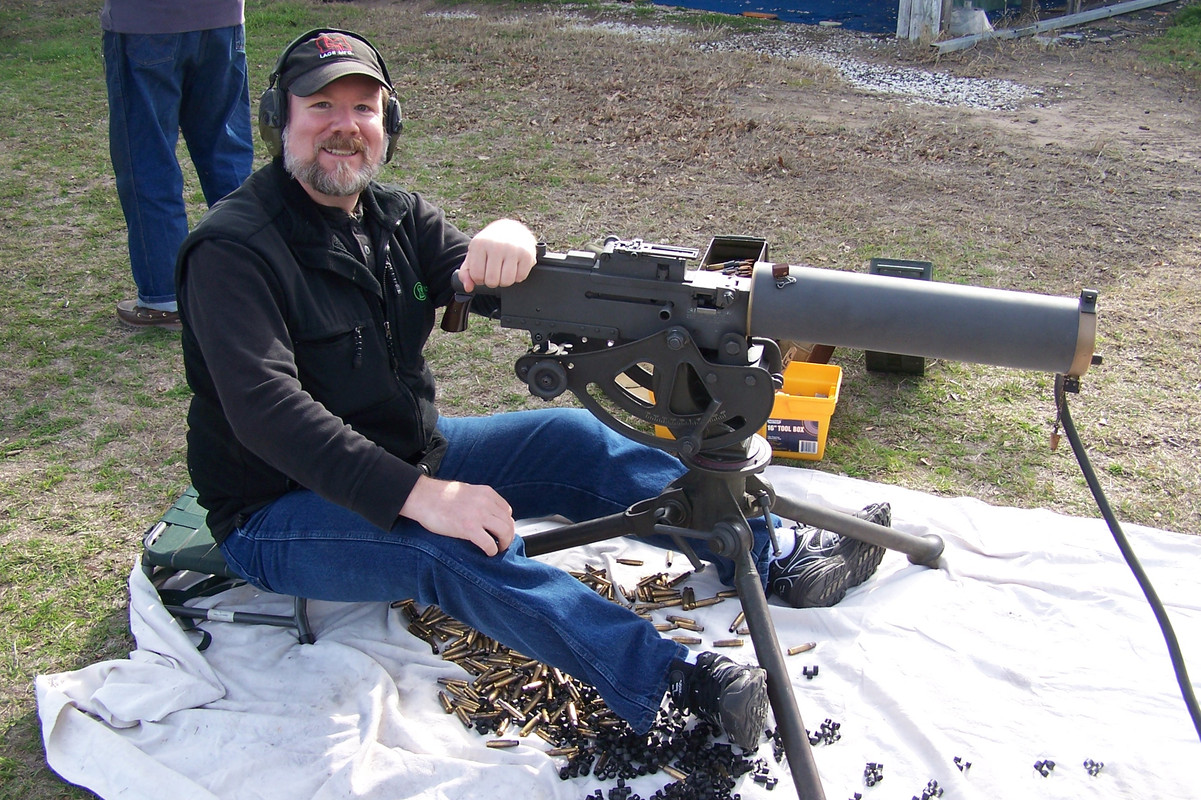
One final note of irony; I brought my '17A1 to one of our local MG shoots last Christmas. That shoot was attended by a US Army High Power Rifle shooter. He fell in love with my Browning. A couple weeks after the shoot, he contacted me and asked if I would like to bring it to one of the local Army bases so others could see and play with it. He told me that the US Army would supply all the ammo. Just bring belts and a belt loader along with me. A couple weeks later I was asked to come over to Camp Swift for a day of MG blasting. It was only then that I discovered that the high power rifle shooter was a full bird colonel. He must have had 20 soldiers there who wanted to shoot their grandfathers' water cooled Browning. Even the base commander wanted to do some blasting. Interestingly when I shoot my '17A1, I shoot out to 100 - 200 yards. These army types were shooting out to 600 - 800 yards. They even had spotters using binoculars. They were way too serious for an old fart like me. During this shoot I didn't fire a single shot and spent the majority of my time schooling the enlisted men on the use of an M1918 Browning Belt Loader. They were simply amazed with it.



